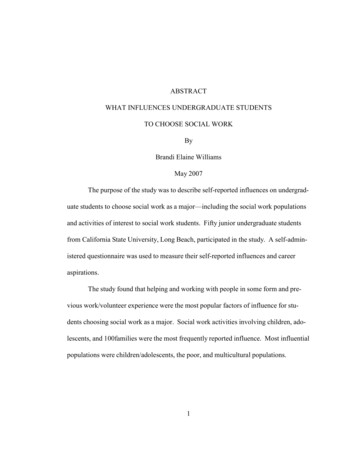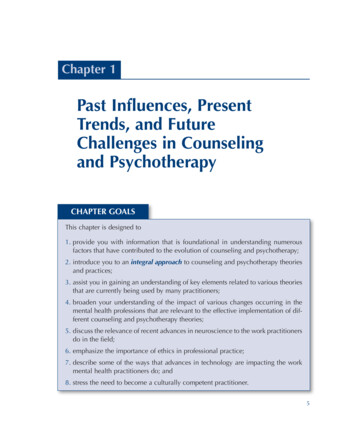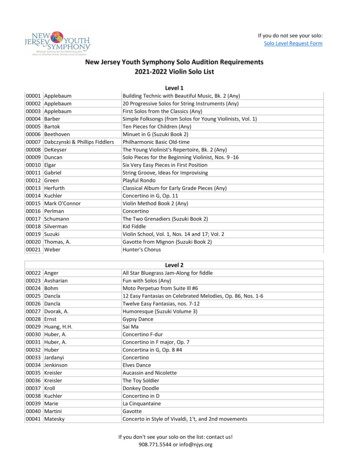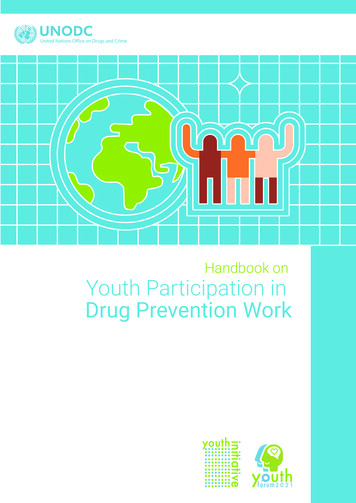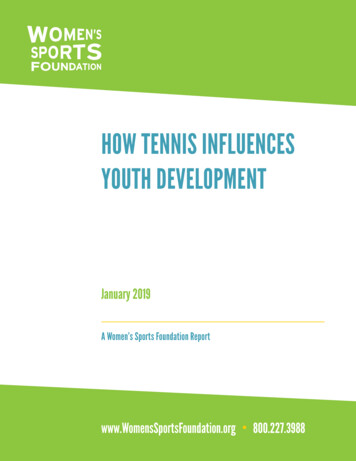
Transcription
HOW TENNIS INFLUENCESYOUTH DEVELOPMENTJanuary 2019A Women’s Sports Foundation Reportwww.WomensSportsFoundation.org 800.227.3988
AcknowledgmentsHow Tennis Influences Youth Development builds on two previous research projects — More Than a Sport: Tennis,Education & Health (2013) and Teen Sport in America: Why Participation Matters (2018) — that view teen sportsas an educational tool and public health asset. We are deeply indebted to Deborah Slaner Larkin, who originallychampioned the idea that each sport might make unique contributions to the health and well-being of Americanyouth and that understanding these benefits would ultimately lead to more opportunities for youth to play sports.She was a powerful advocate and supporter for this line of research when she served as the Executive Director ofthe USTA Serves (now Foundation) and oversaw the development and conduct of the research that resulted in MoreThan A Sport: Tennis, Education, and Health, a first-of-its-kind, nationwide study that compared the educational andhealth profiles of adolescent tennis participants with participants in other non-contact sports and contact sports, aswell as high school students who did not participate in sports. Later, as WSF CEO, she made this line of research anorganizational priority, helped conceptualize the project, and made many important contributions to the final report.And now, we also express our appreciation to her for providing invaluable input from the study design phase to theanalysis and the writing.The Women’s Sports Foundation is indebted to the study author, Philip Veliz, Ph.D., whose scholarly expertise in thehow adolescent behavior is influenced by sports participation brought this project to life. The policy recommendationswere written by Deborah Slaner Larkin and Marjorie Snyder, Ph.D., with valuable input from the USTA Foundation,New York Junior Tennis and Learning, and Tennis Magazine.A special note of acknowledgement and appreciation is extended, as well, to Deana Monahan for her editorial andgraphic skills.This report was made possible through a partnership between the Women’s Sports Foundation and theMargaret Fund.About the Women’s Sports FoundationThe Women’s Sports Foundation — the leading authority on the participation of women and girls in sports —is dedicated to creating leaders by ensuring girls access to sports. Founded by Billie Jean King in 1974, ourwork shapes public attitude about women’s sports and athletes, builds capacities for organizations that getgirls active, ensures equal opportunities for girls and women, and supports physically and emotionally healthylifestyles. The Women’s Sports Foundation has relationships with more than 1,000 of the world’s elite femaleathletes and is recognized globally for its leadership, vision, expertise and influence. For more information, visitwww.WomensSportsFoundation.org.About the MARGARET FundThe MARGARET Fund at the Women’s Sports Foundation was created in 2000 to help identify, fund and promoteprojects that foster gender equality for all in sports.iHow Tennis Influences Youth Developmentwww.WomensSportsFoundation.org 800.227.3988
AuthorshipThis study was authored by Phillip Veliz, Ph.D., Assistant Research Professor at the School of Nursing’s AppliedBiostatistics Laboratory and Associate Director of the Sport, Health, and Activity Research and Policy Center,University of Michigan.Author’s AcknowledgmentsI am grateful to the Women’s Sports Foundation for making this report a reality. Many thanks to Dr. Marjorie Snyder,WSF Senior Director of Research, whose vision, scholarly expertise, and management skills set the stage for asuccessful project. A special note of acknowledgement and appreciation is extended, as well, to Deana Monahan forher editorial and graphic skills. Finally, special thanks to all the researchers who, over time and across a wide varietyof disciplines, have contributed to the growing body of knowledge discussed in this report.For more information, visit www.WomensSportsFoundation.org.Follow us:www.Facebook.com/WomensSportsFoundationTwitter @WomensSportsFdnInstagram @WomensSportsFoundationContact us at Info@WomensSportsFoundation.orgThis report may be downloaded from WomensSportsFoundation.org. This report may be reproduced and distributedonly in its entirety. Any material taken from this report and published or transmitted in any form, electronicor mechanical, must be properly attributed to How Tennis Influences Youth Development published by theWomen’s Sports Foundation.Preferred citation: Veliz, P. (2019). How Tennis Influences Youth Development. New York, NY:Women’s Sports Foundation. 2019 Women’s Sports Foundation, All Rights Reserved.iiHow Tennis Influences Youth Developmentwww.WomensSportsFoundation.org 800.227.3988
TABLE OF CONTENTS2 Executive Summary2 Methods3 Key Findings5 Introduction7 Section 1: Trends in Tennis Participation between 2006 and 20167 Gender15 Section 2: Assessing Behaviors and Outcomes among Adolescent Tennis Players15 Assessing Participation, Academic Achievement, Extracurricular Activities, Community Service, andSubstance Use32 Assessing Healthy Behavior, Physical Activity, and Psychological Outcomes40 Section 3: What Sports Tend to Have the Healthiest (Physically, Psychologically, and Socially) andHighest Achieving Students?42 Which Other Sports Are Tennis Players Most Likely to Participate in During the Past 12 Months?44 Conclusion464646464647Policy RecommendationsFurther Research NeededIncrease Tennis ParticipationIncrease the Diversity of Tennis PlayersImprove the Health Behaviors of Tennis PlayersPlay More Than Just Tennis48 Appendix A: Sample Size Index49 Appendix B: Measures Index57 Appendix C: Details on Latent Class Analysis58 References1How Tennis Influences Youth Developmentwww.WomensSportsFoundation.org 800.227.3988
EXECUTIVE SUMMARYIn 2012 USTA Serves (USTAF) commissioned the Women’sDeborah Slaner Larkin, through the MARGARET FundSports Foundation (WSF) to conduct a research studyat the WSF commissioned the WSF to update the datato compare the education and health profiles of youthfrom More Than a Sport and, as it specifically relates totennis participants with participants in other contacttennis, build on the findings of the Teen Sport Reportand non‑contact sports, as well as students who doby examining participation and retention levels as wellnot participate in sports. The purpose was to provideas what combination of sports is associated with thequantitative research for the USTA, National Junior Tennisbest academic, social, health, and behavioral outcomesand Learning (NJTL) organizations, and other youth-servingamong adolescents.sports organizations to determine how tennis participationpositively influences the lives of U.S. youth across allsocioeconomic levels. More Than a Sport: Tennis, Education& Health (More Than a Sport) was released in 2013.MethodsThe research is based on an analysis of the Monitoringthe Future (MTF) nationwide surveys, a federally fundedFive years later, the WSF commissioned Teen Sport incross‑sectional study of American secondary studentsAmerica: Why Participation Matters (Teen Sport Report) toconducted by researchers at the Institute for Socialbetter understand the impact of sports participation on teenResearch at the University of Michigan.health, well-being and academic achievement. The purposewas to understand how each sport impacts teen well‑beingand whether the number of sports in which a teenparticipates influences their health. The report also exploredwhether sports opportunities overall, as well as individualsports, are accessible to all teens across genders, race andethnicities, levels of family income, and regions. Finally, wewanted to identify the unique benefits and opportunities forimprovement that exist within each sport to maximize thehealth benefits for teens.The Section 1 sample includes eighth-, 10th- and12th‑graders who participated between 2006 and 2016.The sample includes roughly 115,000 adolescents of whichapproximately 8,000 indicated participating in tennis at acompetitive level during the past year (including 54,048adolescents from the first report, of which 4,278 weretennis players). Nine sports were examined in the initialMore Than a Sport report. Comparisons were made bysport and between non-participation/contact/non-contactsports and tennis. In the Teen Sport Report 20 sportswere examined and 15 of those were included in this2How Tennis Influences Youth Developmentwww.WomensSportsFoundation.org 800.227.3988
report: cross country, baseball/softball, basketball, field3. Tennis retains its core participants. Despite thehockey, gymnastics, football, ice hockey, lacrosse, soccer,decline in overall participation rates in tennis amongswimming/diving, tennis, track, volleyball, weightliftingboys and girls across the two time periods, the overalland wrestling.retention rate between eighth and 12th grade increasedfor both boys (90% to 105%) and girls (60% to 84%).Section 2 consists of roughly 14,000 12th-graders who weresurveyed between 2010 and 2015 (roughly 2,500 who were4. Most tennis participants play more than one sport.randomly selected to fill out one of six possible forms) fromMore than three-quarters (77%) of boys and 58% of girlsthe Teen Sports Report. Roughly 700 respondents indicatedwho participated in tennis also participated in at leastparticipating in tennis at a competitive level during the pastone other sport within their school or community. Whenyear. In addition, a group of students that reported theconsidering the top 10 most popular sports, boys whohighest levels of every outcome from the Teen Sport Reportplayed tennis were most likely to participate in soccerwas analyzed.and swimming. Girls were most likely to play soccerand lacrosse.Section 3 uses the same 12th-grade sample as Section 2.A latent class analysis (LCA) was used to create groups5. Tennis and school are a good match. Overall, tennisbased on measures assessing diet and nutrition, physicalreported one of the highest rankings with respect toactivity, substance use, academic achievement, andacademic achievement (highest or second-highestpsychological health.across five separate measures – percentage of A’s,Key Findings1. Most sports report participation declines. Therehas been a small decline among tennis participationfor both boys and girls between 2006 and 2016(boys, 7.8% versus 5.8%; girls, 8.0% versus 6.1).2. The diversity of boys who play tennis is increasing.week, college attendance aspiration, and collegegraduation aspiration). Importantly, these outcomesassessing academic achievement typically increasedacross the two study periods. In particular, morethan 70% of boys and girls who participated in tennisindicated that they would definitely go to and graduatefrom a four-year college. Overall, tennis ranked theA notable change in the composition of tennislowest among the 15 sports for both suspensionparticipants across the two time periods (2006‑10(15.9%) and being sent to the office (24.2%).versus 2011-16) was found in the increase in thepercentage of boys who identified as “Other Race”(18.8% to 24.2%).3average grade, 10 or more hours of homework perHow Tennis Influences Youth Developmentwww.WomensSportsFoundation.org 800.227.3988
6. Tennis benefits youth from all socioeconomicindicating getting at least seven hours of sleep everygroups. Consistent with the first study, theday. Tennis also ranked below average among athletesassociations presented held for various socioeconomicwith respect to exercising vigorously every day.groups. While adolescents who came from higherAmong youth who were physically active for sevenSES backgrounds tended to have better academic,days during a typical week, boys who participatedbehavioral, social, and health outcomes, the impact ofin tennis ranked above average among athletes andtennis was similar across all socioeconomic groups.girls who participated in tennis ranked below averageamong athletes.7. Tennis players are less prone to risky behaviors.Overall, tennis participants had some of the lowest10. Among the top 10 most popular sports, tennisrates of binge drinking, marijuana use, and cigarettehas the highest of the “healthy high achievers.”use across the 15 different sports: second-lowest forAmong the group of students who had the highestbinge drinking, second-lowest for marijuana use, andlevel of academic achievement, lowest prevalence ofthird‑lowest for cigarette use. The prevalence ratessubstance use, lowest school misbehavior, highestfor binge drinking, smoking marijuana, and smokingprevalence of health behaviors, and highest level ofcigarettes dropped between the two study periodspsychological health (Healthy High Achievers), boysamong both boys and girls who participated in tennis.who participated in tennis had the highest percentage8. Tennis players are psychologically healthy. Tennisranked above average among athletes on all measuresof psychological health (self-esteem, loneliness, andself-derogation) with the exception of social support,in which boys who participated in tennis ranked belowaverage when compared to other athletes.9. Tennis players engage in healthy eating but needmore sleep and physical activity. Tennis rankedabove average among athletes on all measuresassessing healthy behaviors (eat breakfast, greenvegetables, and fruit every day). However, tennisranked as one of the lowest with respect to adolescents4How Tennis Influences Youth Developmentwww.WomensSportsFoundation.org 800.227.3988across all sports (31.4%) and their girl counterpartsranked sixth (23.4%).
INTRODUCTIONSport is the most popular extracurricular activity in theinformation on tennis participants, more than five yearsUnited States (Veliz, Snyder, and Sabo, 2018; Veliz, 2015).have passed since the original report, and it is necessary toWhile some surveys of youth have found that participationre-examine these
The Women’s Sports Foundation has relationships with more than 1,000 of the world’s elite female athletes and is recognized globally for its leadership, vision, expertise and influence. For more information, visit www.WomensSportsFoundation.org. About the MARGARET Fund The MARGARET Fund at the Women’s Sports Foundation was created in 2000 to help identify, fund and promote




